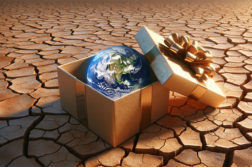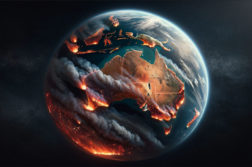Earlier this month, James Hansen resigned from his position as director of NASA's Goddard Institute for Space Studies in order to devote more time to campaigning to cut global carbon emissions.
In addition to his scientific research on climate change, Hansen has been arrested several times in recent years at protests against coal mining and tar sands mining. Bravo James Hansen — precious few scientists and academics live and breathe their politics as he does.
But when it comes to proposing solutions, Hansen is on less solid ground. A loose parallel can be drawn with Tim Flannery, who Clive Hamilton describes as a "talented science populariser" but a "policy flake".
I met Hansen at an IQ2 debate in front of 1200 people at the Melbourne Town Hall in 2010. He was on the pro-nuclear side of the debate, I was on the other side. The audience was polled before and after the debate and many were deeply unimpressed by Hansen's nuclear advocacy — 32 per cent of the audience switched from pro-nuclear or undecided to anti-nuclear over the course of the debate. The final poll showed 34 per cent in favour of nuclear power, 58 per cent against. A frustrated account of the debate from right wing magazine Quadrant can be read here.
Hansen has continued with his nuclear power advocacy. Indeed, he has become more strident. Recently he co-authored an article with Pushker Kharecha, published in the journal Environment, Science and Technology, that radically understates the risks of nuclear power.
The authors claim that between 1971 and 2009, "global nuclear power has prevented an average of 1.84 million air pollution-related deaths and 64 gigatonnes of CO2-equivalent greenhouse gas emissions that would have resulted from fossil fuel burning". They also calculate that "nuclear power could additionally prevent an average of 420 000–7.04 million deaths and 80–240 GtCO2-eq [equivalent gigatons of carbon dioxide]emissions due to fossil fuels by midcentury, depending on which fuel it replaces [gas or coal]".
Kharecha and Hansen ignore the potential of renewables and energy efficiency and conservation. Instead they set up a false choice between fossil fuels and nuclear. Even as an assessment of the relative risks of nuclear and fossil fuels, the article doesn't stack up. Nonetheless, it has gone down a treat with the nuclear lobby. World Nuclear News describes it as a "landmark study" and states that it "presents a dramatic new case for nuclear energy".
Four thousand nine hundred deaths have resulted from nuclear power between 1971 and 2009, Kharecha and Hansen state. "About 25 per cent of these deaths are due to occupational accidents and about 70 per cent are due to air pollution-related effects (presumably fatal cancers from radiation fallout; see Table 2 of ref 16)."
"Ref 16" points to a 2007 article in The Lancet on nuclear power deaths that makes no effort to explain or justify its figures. You'd hope the authors might do better than borrowing someone else's figures and guessing what they might mean. And you have to wonder why a peer-reviewed journal would accept an article that relies on a borrow and a guess for one of its key claims.
They continue: "[E]mpirical evidence indicates that the April 1986 Chernobyl accident was the world’s only source of fatalities from nuclear power plant radiation fallout." What empirical evidence? Why narrow the focus from the full energy cycle to power plants? And why limit consideration of fatalities to radiation fallout alone? There have been countless fatal accidents at nuclear fuel cycle facilities.
Kharecha and Hansen cite the UN Scientific Committee on the Effects of Atomic Radiation (UNSCEAR) to justify their figure of 43 deaths at Chernobyl. But the UNSCEAR report did not attempt to calculate long-term deaths from radiation exposure from Chernobyl, citing "unacceptable uncertainties in the predictions". The credible estimates of the Chernobyl death toll range from 9000 (in Eastern Europe) to 93,000 (across Eastern and Western Europe).
Regarding Fukushima, Kharecha and Hansen state that "one early analysis indicates that annual radiation doses in nearby areas were much lower than the generally accepted 100 millisievert threshold for fatal disease development." In defence of the claim regarding a 100 mSv threshold, they cite (and misrepresent) an UNSCEAR report. The UNSCEAR report (p.183) claims that no studies provide conclusive evidence of carcinogenic effects of radiation at levels below 100 mSv, which is also disputed (see for example the paper by Nuclear Radiologist Peter Karamoskos).
In any case, UNSCEAR is not claiming that radiation doses below 100 mSv do not cause cancer, but rather that evidence is lacking for such effects. Indeed UNSCEAR's view is that "the current balance of available evidence tends to favour a non-threshold response for the mutational component of radiation-associated cancer induction at low doses and low dose rates." Kharecha and Hansen's assertion regarding a 100 mSv threshold isn't even UNSCEAR's position let alone a "generally accepted" position.
There are many reasons to conclude that Kharecha and Hansen's figure of 4900 deaths from nuclear power from 1971 to 2009 is a gross underestimate, yet they claim that the figure "could be a major overestimate relative to the empirical value (by two orders of magnitude)".
The linear no-threshold (LNT) model of radiation risk "might not be valid for the relatively low radiation doses that the public was exposed to from nuclear power plant accidents," the authors say. But it enjoys some weighty real-world support. The Committee on the Biological Effects of Ionising Radiation of the US National Academy of Sciences states that "the risk of cancer proceeds in a linear fashion at lower doses without a threshold and … the smallest dose has the potential to cause a small increase in risk to humans."
Australian NGOs, like Choose Nuclear Free, have attempted a comparative risk assessment that overcomes the flaws evident in studies like Kharecha and Hansen's. To give a quick summary, comparisons of the risks associated with different energy sources need to consider several factors:
- Power plant accidents.
- Accidents at other stages of the energy cycle.
- Impacts of routine operations and emissions.
- Attacks on power plants and other stages of the energy cycle (by nation-states or sub-national groups).
- Weapons/WMD proliferation risks.
Claims that nuclear power is safe, or that it is one of the safest energy sources, often rest on flawed assessments of the risks and impacts of power plant accidents, and completely ignoring the other four aspects of risk assessment. When both accidents and routine emissions across the energy chain are considered, renewable energy sources are shown to be far less hazardous than both coal and nuclear power.
The connection between fossil fuels and global warming, and the connection between the civil nuclear fuel cycle and nuclear weapons proliferation, are arguably the greatest hazards associated with all energy sources. They're represented qualitatively in the following table since they cannot be quantified:
|
Fatalities per gigawatt-year |
|
|
Coal |
9.7 − 31.2 + global warming |
|
Nuclear |
<8.2 − 31.4 + WMD proliferation |
|
Oil |
4.5 + global warming |
|
LPG |
3.5 + global warming |
|
Biomass |
1.4 |
|
Hydro |
0.6−4.3 (higher figure includes a major dam accident in China in 1975) |
|
Gas |
0.5 + global warming |
|
Solar (rooftop) |
0.05 |
|
Wind |
0.02 |
The Choose Nuclear Free paper emphasises the high degree of uncertainty associated with many of the figures in the above table. Nevertheless, the broad picture is clear enough: renewables are benign (excepting some major hydropower accidents). Coal and nuclear are not.
The authors state: "Serious questions remain about [nuclear]safety, proliferation, and disposal of radioactive waste, which we have discussed in some detail elsewhere." But the paper they refer to doesn't come close to providing a detailed discussion of these crucial issues. They acknowledge in passing the "potential mortality from proliferation of weapons-grade material", but, dismiss it, on the grounds that it "cannot meaningfully be quantified".
Donate To New Matilda
New Matilda is a small, independent media outlet. We survive through reader contributions, and never losing a lawsuit. If you got something from this article, giving something back helps us to continue speaking truth to power. Every little bit counts.



